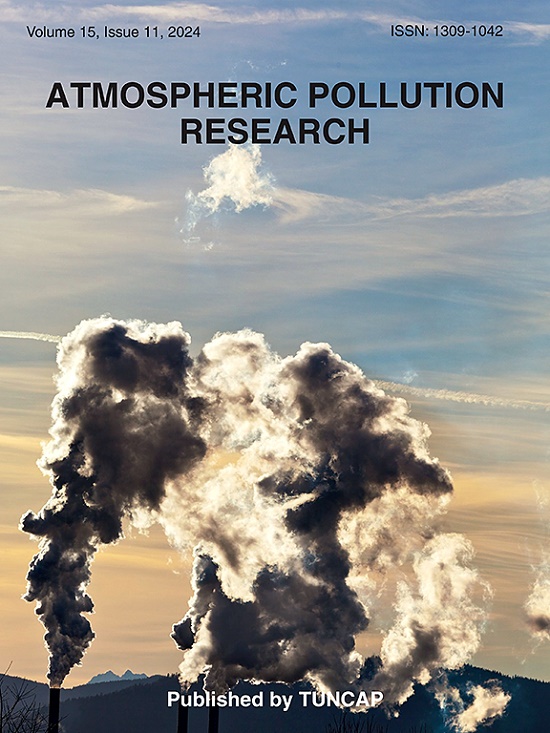印度金奈不同室内环境中人为微纤维的大气沉降
IF 3.5
3区 环境科学与生态学
Q2 ENVIRONMENTAL SCIENCES
引用次数: 0
摘要
微塑料,特别是微塑料纤维,是新兴的污染物之一。然而,最近的研究强调了人造和天然微纤维比微塑料纤维的优势。尽管如此,对所有类型的微纤维(通常被归为人为微纤维(MFs))的研究仍然有限,特别是在住宅室内环境中。因此,本研究探讨了印度钦奈住宅室内MFs沉积,这是该国首次进行此类研究。此外,还检查了工作场所,包括办公室、实验室和宿舍房间。卧室(16,736±7,263 MF/m2/天)和学生宿舍(5,572±2,898 MF/m2/天)在各自类别中污染最高,这可能归因于两个房间中大量的纺织品。MFs<;500 μm在住宅(78.8%)和工作场所(65.9%)中占主导地位。观察到的MFs直径(2.02 ~ 36.4 μm)表明它们有穿透人体肺部的潜力。μ-FTIR分析显示半合成(48.2%)、天然(29.3%)和合成(22.5%)的MFs分布,强调需要考虑所有类别的MFs。进一步分类显示,纺织品(人造丝- 94.5±6.40%,棉- 68.1±6.12%,聚对苯二甲酸乙二醇酯(PET) - 48.1±11.5%)是主要污染源。黑色橡胶/乳胶颗粒的检测表明道路灰尘也起到了额外的作用。表面形态分析进一步强调了室内/局部来源在微尘污染中的主要作用。总的来说,该研究强调需要监测所有类别的微尘,并呼吁对各种来源对室内微尘污染的影响进行全面调查。本文章由计算机程序翻译,如有差异,请以英文原文为准。

Atmospheric deposition of anthropogenic microfibers in different indoor environments of Chennai, India
Microplastics, particularly microplastic fibers, are one of the emerging pollutants of concern. However, recent studies emphasized the predominance of artificial and natural microfibers over microplastic fibers. Despite this, research focusing on all types of microfibers, commonly grouped as anthropogenic microfibers (MFs) remains limited, especially in residential indoor environments. Therefore, this study explored the indoor MFs deposition in the residential homes of Chennai, India, a first such study in the country. Additionally, workplaces, including offices, laboratories, and hostel rooms, were examined. Bedrooms (16,736 ± 7,263 MF/m2/day) and student hostels (5,572 ± 2,898 MF/m2/day) recorded highest contamination in respective categories, and this could be attributed to the abundance of textile products in both the rooms. MFs<500 μm dominated in both residential (78.8 %) and workplace (65.9 %) samples. The observed diameter of MFs (2.02–36.4 μm) indicate their potential to penetrate human lungs. μ-FTIR analysis revealed the distribution of semi-synthetic (48.2 %), natural (29.3 %) and synthetic (22.5 %) MFs, underscoring the need to consider all categories of MFs. Further classification revealed textiles (rayon - 94.5 ± 6.40 %, cotton - 68.1 ± 6.12 %, and polyethylene terephthalate (PET) - 48.1 ± 11.5 %) as a significant source of contamination. The detection of black rubber/latex MFs indicates additional contributions from road dust. Surface morphological analysis further highlighted the primary role of indoor/local sources in MFs contamination. Overall, the study emphasizes the need to monitor all categories of MFs and calls for comprehensive investigations into the impact of various sources on indoor MFs contamination.
求助全文
通过发布文献求助,成功后即可免费获取论文全文。
去求助
来源期刊

Atmospheric Pollution Research
ENVIRONMENTAL SCIENCES-
CiteScore
8.30
自引率
6.70%
发文量
256
审稿时长
36 days
期刊介绍:
Atmospheric Pollution Research (APR) is an international journal designed for the publication of articles on air pollution. Papers should present novel experimental results, theory and modeling of air pollution on local, regional, or global scales. Areas covered are research on inorganic, organic, and persistent organic air pollutants, air quality monitoring, air quality management, atmospheric dispersion and transport, air-surface (soil, water, and vegetation) exchange of pollutants, dry and wet deposition, indoor air quality, exposure assessment, health effects, satellite measurements, natural emissions, atmospheric chemistry, greenhouse gases, and effects on climate change.
 求助内容:
求助内容: 应助结果提醒方式:
应助结果提醒方式:


